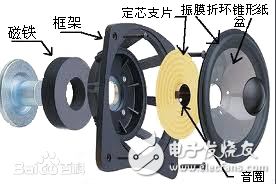The earpiece is a kind of accessory for transmitting sound by telephone, intercom, mobile phone and other communication tools, and it is also a kind of speaker, but it is generally not called a speaker. Generally, the word is used to describe the sound transmission parts of electronic products. Such as: mobile phones, walkie-talkies, etc.
There is a small membrane in the microphone and the earpiece. The membrane in the microphone acts as a tympanic membrane in the human ear. When you speak to it, the membrane will vibrate, and the membrane is connected to a small coil And change the position), there is a small fixed permanent magnet in the microphone (fixed on the microphone shell). The film is elastic, and generally acts as both a vibration and a coil to return to the initial position. The film is fixed on the microphone shell at one end and connected to the coil at the other end.
When the thin film vibrates, the coil is driven to vibrate, and the relative position of the coil and the permanent magnet changes. This changes the magnetic field passing through the coil. When the magnetic field changes, an induced electromotive force is generated in the coil, which also generates a current. Certain sounds have certain vibrations, and certain vibrations generate certain forms of electric current. So the microphone "codes" the sound into a form of electric current.
The principle of the earpiece is probably the reverse process of the microphone, and the structure is almost the same. There is also a film in the earpiece, which is connected to a coil, and also has a permanent magnet. A specific form of current (such as the current that the microphone just "encoded") flows through the coil of the earpiece, which changes the magnetic field generated by the coil, so the magnetic force between the permanent magnet and the coil changes, so the distance between the permanent magnet and the coil Will change. This caused the membrane to vibrate and make a sound.
speakerThe speaker is also called "speaker". It is a very commonly used electroacoustic transducing device, and it can be seen in sounding electronic and electrical equipment.
Composition structure
The speaker is a kind of transducing device that converts electrical signals into acoustic signals. The performance of the speaker has a great influence on the sound quality. The speaker is one of the weakest devices in the audio equipment, and for the sound effect, it is also the most important component. There are many types of speakers, and prices vary widely. Audio electrical energy makes its paper cone or diaphragm vibrate and resonates (resonates) with the surrounding air by electromagnetic, piezoelectric, or electrostatic effects to produce sound.
Low-end plastic speakers have no sound quality due to their thin box, unable to overcome resonance (and some well-designed plastic speakers are much better than inferior wooden speakers); wooden speakers reduce the sound stain caused by the resonance of the cabinet, The sound quality is generally better than plastic speakers.
Usually multimedia speakers are dual-unit two-way frequency design, a smaller speaker is responsible for the output of midrange and treble, and another larger speaker is responsible for the output of midrange and bass.
The selection of speakers should consider the materials of these two speakers: the tweeters of multimedia active speakers are currently domed with soft domes (in addition to titanium membrane domes used for analog sound sources, etc.), which can reduce high frequencies when combined with digital sound sources The stiffness of the signal gives a gentle, smooth and delicate feeling. Multimedia speakers are now dominated by soft domes with better quality silk films and lower cost PV films.
The woofer determines the characteristics of the sound of the speaker. The selection is relatively important. The most common ones are the following: paper cones, glue-coated paper cones, paper-based wool basins, and compact pressure basins. Paper cones have natural sound, cheap, good rigidity, lighter materials and high sensitivity. The disadvantages are poor moisture resistance and difficult to control consistency during manufacturing. However, paper cones made in top HiFi systems are everywhere because the sound output is very average. Good reduction.

Common speakers
Bulletproof cloth, with wider frequency response and lower distortion, is the first choice for those who love strong bass. The disadvantages are high cost, complicated production process, low sensitivity and low music effect.
The wool woven basin has a soft texture, and it is very good for soft music and light music, but the bass effect is not good, lacking strength and shock.
PP (polypropylene) basin, it is widely popular in high-end speakers, good consistency and low distortion, all aspects of performance are remarkable. In addition, there are few diaphragms such as fiber diaphragms and composite diaphragms that are rarely used in popular speakers due to their high price.
The size of the speaker is naturally the larger the better, the large-diameter woofer can perform better in the low-frequency part, which can be selected in the purchase. Speakers made with high-performance speakers mean lower transient distortion and better sound quality. Ordinary multimedia speakers and woofer speakers are mostly between 3 and 5 inches. Speakers made with high-performance speakers also mean lower transient distortion and better sound quality.
Our most common electric cone-shaped cone speakers. Electric cone speakers are what we often call paper cone speakers in the past. Although the diaphragm was still dominated by paper cones in 2014, many polymer material diaphragms and metal diaphragms also appeared at the same time. Actually. The cone-shaped paper cone speaker is generally composed of three major parts: magnetic circuit system (permanent magnet, core post, magnetic permeable plate), vibration system (paper cone, voice coil) and supporting auxiliary system (centering support piece, basin frame, cushion edge) Partial composition.
1. Voice coil: The voice coil is the drive unit of the cone-shaped paper cone speaker. It is wound on the paper tube in two layers with very thin copper wires, generally around dozens of coils, also called coils, placed on the magnetic core column and In the magnetic gap formed by the magnetic conductive plate. The voice coil and the paper cone are fixed together. When the sound current signal passes through the voice coil, the vibration of the voice coil drives the paper cone to vibrate.
2. Paper cone: There are many types of materials used in the cone diaphragm of cone paper cone speakers, generally two types of natural fibers and artificial fibers. Natural fibers often use cotton, wood, wool, silk, etc., and artificial fibers use rayon, nylon, glass fiber, etc. Because the paper cone is the sound radiating device of the speaker, it determines the sound performance of the speaker to a large extent, so no matter what kind of paper cone, it is required to be lightweight and rigid, and not deformed due to changes in ambient temperature and humidity .
3. Folding ring: The folding ring is set to ensure that the paper cone moves along the axial direction of the loudspeaker and restricts the lateral movement, and at the same time plays a role in blocking the dare to circulate in the front and back of the paper cone. In addition to the commonly used paper cone materials, the material of the folding ring also uses plastic, natural rubber, etc., and is bonded to the paper cone after hot pressing.
4. Centering support piece: The centering support piece is used to support the joint of the voice coil and the paper cone to ensure that it is vertical and not skewed. There are many concentric rings on the centering support piece, so that the voice coil can move up and down freely in the magnetic gap without lateral movement, to ensure that the voice coil does not collide with the magnetic conductive plate. The dust cover on the centering support piece is to prevent external dust from falling into the magnetic gap, to avoid friction between the dust and the voice coil, and to make the speaker produce abnormal sound.

Speaker construction
The general speaker is composed of: magnet, frame, centering support piece, die-folding cone-shaped paper cone. As shown

Speaker construction
The difference between earpiece and speakerThe earpiece is a kind of accessory for transmitting sound by telephone, intercom, mobile phone and other communication tools, and it is also a kind of speaker, but it is generally not called a speaker. Generally, the word is used to describe the sound transmission parts of electronic products. Such as: mobile phones, walkie-talkies, etc.
The speaker is a kind of transducing device that converts electrical signals into acoustic signals. The performance of the speaker has a great influence on the sound quality. The speaker is one of the weakest devices in the audio equipment, and for the sound effect, it is also the most important component. There are many types of speakers, and prices vary widely. Audio electrical energy makes its paper cone or diaphragm vibrate and resonates (resonates) with the surrounding air by electromagnetic, piezoelectric, or electrostatic effects to produce sound.
Damping and Absorption Capacitors
MKP capacitor
The products have a high share in China, and also used for INDUCTOTHERM,ELECTROTHERM,MEGATHERM,PILLAR,SUPERHEAT,ABP , Mitsubishi electric, Fuji, the United States Yingda equipment and other manufacturers of induction Furnace.
MKP Capacitor,MKP Capacitor 0.15UF,MKP Capacitor 20UF,MKP Capacitors 0.22UF
YANGZHOU POSITIONING TECH CO., LTD. , https://www.yzpst.com
